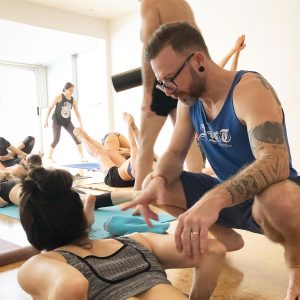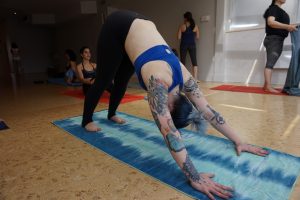With the progressive sequencing of the Ashtanga system, it’s easy to get caught up in feeling like you need to “get more” poses in order to “push yourself” in your practice.
Sometimes I feel that way, and maybe you can relate.
This practice draws in us “pushers.” The Yogis who like to hang out at the edge of their potential each and every day. The ones who crave discipline, and thrive on advancing in their practice.
But sometimes Ashtanga demands that we scale back. Sometimes it asks that we stop at half primary, or before – perhaps because of injury, or other physical limitations.
I’ve heard people criticize Ashtanga for this in the past.
“I don’t feel tired after my practice, and I know I can do more!”
Well… Let me tell you right now, there is plenty of work to be done – even in standing – that will leave you feeling cursing yourself for even asking.
Has David ever adjusted you in Samasthiti?
He makes that pose feel hard.
If you’re finding yourself feeling “stuck” and “without work” in your practice, here’s a few postures you can start working on, that will leave you feeling stronger, and far more tired after practice.
3 Fundamental Poses That Will Challenge Your Practice
Chaturanga Dandasana

What sparked my inspiration for this post was a recent adjustment I got in Chaturagna Dandasana. I wasn’t doing it “wrong,” but there were tiny shifts to be made.
Check out David’s video tutorial on correct alignment in Chaturanga – he explains and demonstrates this really well. But for now, I’ll give you a couple tips that I’m personally working on right now:
- Tuck your tailbone, and pull up on the lower belly
It almost feels counterintuitive, and something I realized I was doing, was arching my lower back. And sometimes, when I’m not fully focused on my practice and I’m looking around the room (which RARELY happens btw 😉 ), I see many people doing this too.
Tucking your tailbone slightly helps keep your bandhas engaged, and maintains the engagement of your core.
- Keep your chest and chin forward
This is the part that perhaps I struggle with most. In Chaturanga we want to keep our tailbone tucked, whilst also keeping our chest and chin forward. For some reason putting this together feels like patting my head, and circling my tummy. I am struggling to wrap my head around it, and connect the dots right now, and it feels like when I get one, I lose the other! But this work is important!
I’m taking some time to slow down in my vinyasa to focus on finding the work here. Something I’ve noticed is that it’s helping me strengthen my lats, and taking the work out of the front of my shoulders (which are tight to begin with).
Upward Dog

Another simple posture, where there’s lots of work to be done. It’s easy to just breeze past this one, but when done correctly it can set you up for success in your backbends and your dropbacks.
You’re welcome!
Try these tips in your next practice:
- Strong Legs, Soft Bum
DR’s backbending mantra applies here! Next time you’re in upward dog, press the tops of the feet into the floor, and engage your quads and hamstrings will softening those glutes. This will keep the back safe, and also build strength in the legs with backbends and dropping back.
- Keep a slight internal rotation of the shoulders
When I first started making this adjustment, it seemed counter-intuitive. But a slight internal rotation at the shoulders is the correct alignment in this posture. Use your hands to pull your chest forward, and think about lifting up from the bottom ribs.
Hint: this is the same action you’ll use in backbends to create more depth and strength.
Downward Dog

Another great pose to use as a break. NOT!
This posture, when done correctly, is very tiring, and also builds a ton of strength! Here are a few ways to make downward dog more than a hang out spot:
- Engage your quads
Maybe this is an obvious suggestion, but honestly I’m sure many people hang out here – I used to, and when I’m not being mindful, sometimes I still do! Eeeek!
Engaging your quads in this posture is a great way to help bring your heels to the ground (something I personally struggle with). It helps build connection, and create muscle awareness. Understanding how to engage your quadriceps is an important part of this practice that will help you in dropbacks and beyond!
…and keeping them engaged for a David Robson count is very, very tiring.
- Keep your bandhas engaged.
Pull in on the lower belly, and keep it pulled in for five whole breaths. I find this particularly difficult in downward dog. But having strong bandhas is important in Ashtanga, and downward dog is a simple posture where you can practice that work!
So there you have it, three postures (that you do like a hundred times each practice) that will have you cursing my name (and Robsons, because I’m just regurgitating what my teacher tells me #don’tshootthemessenger).
You don’t have to do tick tocks, or kapotasana to feel like you’ve worked your ass off in your practice.
Perfecting these fundamental postures is hard work, but they will pay off in dividends down the road.
When we perfect these “basic” asana, we lay a solid foundation of strength, and movement patterns that will support us when we progress down the road.
So don’t stress if you need to scale back, but you still want to work hard. There’s always work to be done.
Try these out, and let us know how it goes!

Great read & reminders…..thanks 🙂
Basic asanas can do wonders for your body, just keep doing them with sincerity and regularity.